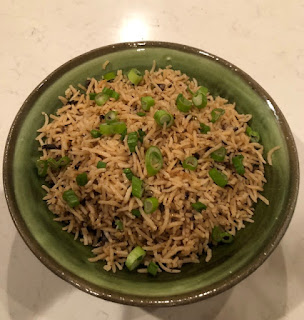Louisiana-Style “Dirty Rice” made with
Mushrooms
“Dirty Rice” is a Louisiana-Cajun sort of rice
pilaf in which the rice was traditionally cooked with finely chopped chicken
livers, ground meat or sausage, plus seasonings. I prefer it made with chopped
dark mushrooms rather than chicken giblets. That idea came from having the
wonderful Riz Djon-Djon in Haiti, a specialty rice dish enriched as well as
colored a rich brown by local hill-side black
mushrooms. I use Basmati or other
long-grained rice, but in Louisiana cooking medium-grained rice, from Louisiana
or Arkansas, is more typical.
Dirty Rice in Louisiana is
frequently served with stewed red beans. It makes a good side for a number of
savory braised or stewed dishes.
The recipe serves six to eight as
part of dinner.
1 1/2 cups Basmati or other
long-grained rice
1 medium-small onion
1/4 large green bell pepper
1/2 stick celery
1/4 pound (4 ounces) baby Bella or
Portobello mushrooms
3 tablespoons olive oil
1 tablespoon tomato ketchup
1 1/2 teaspoons Cajun Seasoning (or
1/2 tsp salt, 1/2 tsp paprika, 1/4 tsp black pepper, 1/4 tsp celery salt, 1/4
tsp garlic salt, 1/4 tsp cayenne)
1/8 teaspoon black pepper
2 bay leaves
2 1/4 cups low sodium chicken broth
or vegetable broth
Coarsely chopped parsley or thinly
cross-cut green onion tops for garnish
Rinse and drain rice twice to remove
excess starch, and set aside to dry. Finely chop together in a food processor
the onion, bell pepper, celery and mushrooms, or finely mince them on a cutting
board with a chef’s knife.
In heavy cooking pot in which the
rice will be cooked, fry together the minced vegetables and olive oil. Stir
frequently, scraping the bottom of the pot. When the mixture is becoming softer
and darker, add the ketchup, dry seasonings, and bay leaves. Add the drained
rice and stir well. Add broth and stir briefly. Then do not stir again until
cooking is done. Bring pot to the boil, uncovered. When boiling, without
stirring, cover tightly and turn heat to lowest setting. Set timer for 20
minutes. After 20 minutes, turn off heat and allow to rest without opening the
pot for 10 more minutes.
Open pot, remove bay leaves, and
fluff gently with a fork. Cover and keep warm until served. When serving,
sprinkle lightly with chopped parsley or sliced green onion tops.
An alternative cooking method can be
used with a rice cooker. Put drained rice in rice cooker. Fry vegetables and
the olive oil in a pan until color has changed. Add this mixture to the rice in
the rice cooker. Add the ketchup, dry seasonings, bay leaves and broth. Stir
briefly. Cover and cook as usual without opening the cover. When heat goes off,
again without uncovering, let rest 10 more minutes. Then remove bay leaves, and
fluff the rice with a fork. Keep warm until served. Sprinkle with the parsley
or green onion garnish when serving.



















